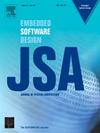通过重构渲染改善Android的UI响应能力
IF 4.1
2区 计算机科学
Q1 COMPUTER SCIENCE, HARDWARE & ARCHITECTURE
引用次数: 0
摘要
Android等移动操作系统越来越多地用于各种应用程序,在这些应用程序中,确保对用户交互的高响应至关重要,特别是在关键任务和实时场景中。移动操作系统通常在同一线程上处理用户交互事件和UI呈现,通常称为移动应用程序的主线程。因此,当被过载的UI呈现任务阻塞时,用户交互处理可能会面临严重的延迟,从而影响响应性。现有的移动操作系统缺乏有效的机制来缓解这个问题。本文通过重构UI渲染工作流来解决这个问题,以提高在大量渲染工作负载下的响应能力。具体来说,提出了两种针对事件处理结果是否需要屏幕显示而定制的技术。实验结果表明,事件处理的平均情况和最坏情况响应时间都有所改善,增强了UI响应性。虽然实现的重点是Android,但所提出的方法适用于具有类似渲染架构的其他移动操作系统,如iOS和HarmonyOS。本文章由计算机程序翻译,如有差异,请以英文原文为准。
Improving UI responsiveness in Android by restructured rendering
Mobile operating systems, such as Android, are increasingly used across diverse applications, where ensuring high responsiveness to user interactions is critical, particularly in mission-critical and real-time scenarios. Mobile operating systems typically process user interaction events and UI rendering on the same thread, commonly referred to as the main thread of a mobile application. As a result, user interaction handling can face significant delays when blocked by overloaded UI rendering tasks, compromising responsiveness. Existing mobile operating systems lack effective mechanisms to mitigate this issue. This paper addresses the problem by restructuring the UI rendering workflow to improve responsiveness in the presence of heavy rendering workloads. Specifically, two techniques are proposed that are tailored to whether the event handling results require screen display. Experimental results demonstrate improvements in both average-case and worst-case response times of event handling, enhancing the UI responsiveness. Although the implementation focuses on Android, the proposed approaches are adaptable to other mobile operating systems with similar rendering architectures, such as iOS and HarmonyOS.
求助全文
通过发布文献求助,成功后即可免费获取论文全文。
去求助
来源期刊

Journal of Systems Architecture
工程技术-计算机:硬件
CiteScore
8.70
自引率
15.60%
发文量
226
审稿时长
46 days
期刊介绍:
The Journal of Systems Architecture: Embedded Software Design (JSA) is a journal covering all design and architectural aspects related to embedded systems and software. It ranges from the microarchitecture level via the system software level up to the application-specific architecture level. Aspects such as real-time systems, operating systems, FPGA programming, programming languages, communications (limited to analysis and the software stack), mobile systems, parallel and distributed architectures as well as additional subjects in the computer and system architecture area will fall within the scope of this journal. Technology will not be a main focus, but its use and relevance to particular designs will be. Case studies are welcome but must contribute more than just a design for a particular piece of software.
Design automation of such systems including methodologies, techniques and tools for their design as well as novel designs of software components fall within the scope of this journal. Novel applications that use embedded systems are also central in this journal. While hardware is not a part of this journal hardware/software co-design methods that consider interplay between software and hardware components with and emphasis on software are also relevant here.
 求助内容:
求助内容: 应助结果提醒方式:
应助结果提醒方式:


